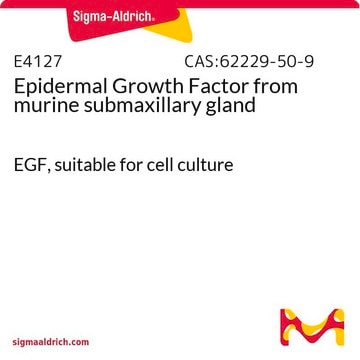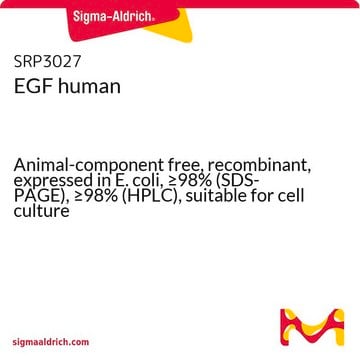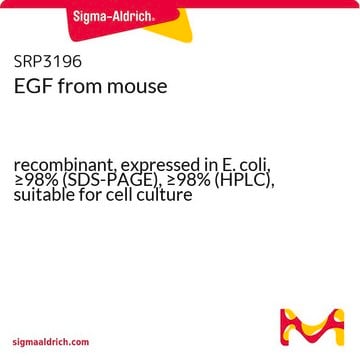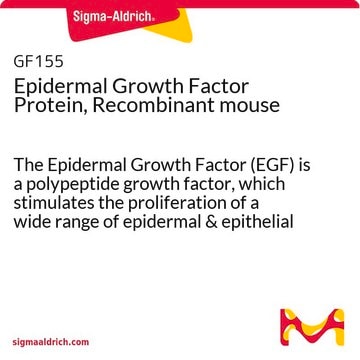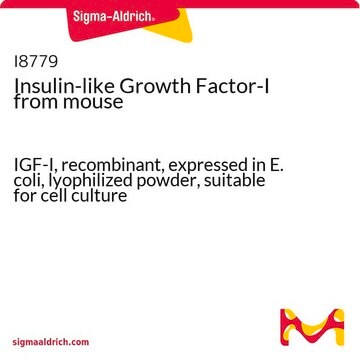おすすめの製品
由来生物
mouse
品質水準
リコンビナント
expressed in E. coli
アッセイ
≥90% (SDS-PAGE)
形状
lyophilized powder
有効性
0.05-1 ng/mL ED50/EC50
分子量
~6 kDa
包装
pkg of 100 μg
保管条件
avoid repeated freeze/thaw cycles
テクニック
cell culture | mammalian: suitable
不純物
≤1 EU/μg endotoxin (Protein)
色
white
溶解性
water: soluble 0.10 mL, clear, colorless
UniProtアクセッション番号
保管温度
−20°C
遺伝子情報
mouse ... Egf(13645)
詳細
上皮増殖因子(EGF)は、細胞分裂促進作用を示す小さいポリペプチド(約6 kDa)で、多くの哺乳類動物種に存在し、広範囲の組織および体液に広く分布します。∼4つのErbB(HER)ファミリー受容体チロシンキナーゼ、すなわちEGFR/ErbB1、ErbB2、ErbB3、およびErbB4は、EGFファミリーメンバーに反応を伝達します。ヒトおよびマウスのEGFはきわめて類似していますが、物理的および化学的特性という面で同一ではありません。この2つのポリペプチドを構成する各53のアミノ酸残基のうち、37残基は両者に共通しており、同じ相対位置に3つのジスルフィド結合が形成されています。
アプリケーション
マウスの上皮増殖因子は、分化したマウス胚幹細胞(E14)の培養に用いる基本培地(N2B27)のサプリメントとして使用されています。
生物化学的/生理学的作用
EGF(上皮成長因子)は、細胞の増殖、分化、および生存に関与します。 さらに、血管新生、胃酸分泌の阻害、多数のホルモンの合成の調節、細胞外マトリックスのタンパク質の合成と代謝回転、骨組織からのカルシウム放出(これにより骨吸収を促進します)、線維芽細胞および上皮細胞の化学誘引、並びに単独または他のサイトカインとの組み合わされて創傷治癒プロセスの媒介などのさまざまな生物学的活動に影響を与えることがわかっています。。 EGFは、線維芽細胞、上皮細胞、内皮細胞、軟骨細胞、SV40-3T3細胞など、多種多様な細胞タイプに対して分裂促進性を示します。
物理的形状
本製品は、凍結乾燥品(PBS溶液、pH 7.4、0.2 μmフィルター滅菌済み)です。
引用
1. Carpenter, G., and Cohen, S., Epidermal growth factor. Annu. Rev. Biochem., 48, 193-216 (1979).
2. Jorissen, R.N., et al., Epidermal growth factor: mechanisms of activation and signaling. Exp. Cell Res., 284, 31-53 (2003).
3. Herbst, R.S., Review of epidermal growth factor receptor biology. Int.J. Radiat. Oncol. Biol., Phys., 59, S21-S26 (2004).
4. Mehta, V.B., and Besner, G.E., HB-EGF promotes angiogenesis in endothelial cells via PI3-kinase and MAPK signaling pathways. Growth Factors, 25, 253-263 (2007).
5. Bower, J.M., et al., The inhibition of gastric acid secretion by epidermal growth factor. Experientia, 31, 825-826 (1975).
6. Schonbrunn, A., et.al., Epidermal growth factor and thyrotropin-releasing hormone act similarly on a clonal pituitary cell strain. Modulation of hormone production and inhibition of cell proliferation. J. Cell Biol., 85, 786-797 (1980).
7. Mimura, Y., et al., Epidermal growth factor induces fibronectin expression in human dermal fibroblasts via protein kinase C delta signaling pathway. J. Invest. Dermatol., 122, 1390-1398 (2004).
8. Warner, M.R. et al., Ametantrone inhibits prostaglandin-mediated resorption in bone organ culture. Prostaglandins, 28, 469-476 (1984).
9. Grotendorst, G.R., et al., EGF and TGF-alpha are potent chemoattractants for endothelial cells and EGF-like peptides are present at sites of tissue regeneration. J. Cell. Physiol., 139, 617623 (1989).
10. Schultz, G., et al., EGF and TGF-alpha in wound healing and repair. J. Cell. Biochem., 45, 346-352 (1991).
11. George-Nascimento, C., et al., Characterization of recombinant human epidermal growth factor produced in yeast. Biochemistry, 27, 797-802 (1988).
2. Jorissen, R.N., et al., Epidermal growth factor: mechanisms of activation and signaling. Exp. Cell Res., 284, 31-53 (2003).
3. Herbst, R.S., Review of epidermal growth factor receptor biology. Int.J. Radiat. Oncol. Biol., Phys., 59, S21-S26 (2004).
4. Mehta, V.B., and Besner, G.E., HB-EGF promotes angiogenesis in endothelial cells via PI3-kinase and MAPK signaling pathways. Growth Factors, 25, 253-263 (2007).
5. Bower, J.M., et al., The inhibition of gastric acid secretion by epidermal growth factor. Experientia, 31, 825-826 (1975).
6. Schonbrunn, A., et.al., Epidermal growth factor and thyrotropin-releasing hormone act similarly on a clonal pituitary cell strain. Modulation of hormone production and inhibition of cell proliferation. J. Cell Biol., 85, 786-797 (1980).
7. Mimura, Y., et al., Epidermal growth factor induces fibronectin expression in human dermal fibroblasts via protein kinase C delta signaling pathway. J. Invest. Dermatol., 122, 1390-1398 (2004).
8. Warner, M.R. et al., Ametantrone inhibits prostaglandin-mediated resorption in bone organ culture. Prostaglandins, 28, 469-476 (1984).
9. Grotendorst, G.R., et al., EGF and TGF-alpha are potent chemoattractants for endothelial cells and EGF-like peptides are present at sites of tissue regeneration. J. Cell. Physiol., 139, 617623 (1989).
10. Schultz, G., et al., EGF and TGF-alpha in wound healing and repair. J. Cell. Biochem., 45, 346-352 (1991).
11. George-Nascimento, C., et al., Characterization of recombinant human epidermal growth factor produced in yeast. Biochemistry, 27, 797-802 (1988).
保管分類コード
11 - Combustible Solids
WGK
WGK 1
適用法令
試験研究用途を考慮した関連法令を主に挙げております。化学物質以外については、一部の情報のみ提供しています。 製品を安全かつ合法的に使用することは、使用者の義務です。最新情報により修正される場合があります。WEBの反映には時間を要することがあるため、適宜SDSをご参照ください。
Jan Code
E5160-100UG:
E5160-VAR:
E5160-BULK:
E5160-100UG-PW:
試験成績書(COA)
製品のロット番号・バッチ番号を入力して、試験成績書(COA) を検索できます。ロット番号・バッチ番号は、製品ラベルに「Lot」または「Batch」に続いて記載されています。
この製品を見ている人はこちらもチェック
Epidermal growth factor: mechanisms of activation and signaling.
Jorissen RN et al.
Experimental Cell Research, 284, 31-31 (2003)
Characterization of recombinant human epidermal growth factor produced in yeast.
George-Nascimento C et al.
Biochemistry, 27, 797-797 (1988)
EGF and TGF-alpha are potent chemoattractants for endothelial cells and EGF-like peptides are present at sites of tissue regeneration.
Grotendorst GR et al.
Journal of Cellular Physiology, 139, 617623 -617623 (1989)
The inhibition of gastric acid secretion by epidermal growth factor.
Bower JM et al.
Experientia, 31, 825-825 (1975)
Dynamics of lineage commitment revealed by single-cell transcriptomics of differentiating embryonic stem cells
Semrau S, et al.
Nature Communications, 8(1), 1096-1096 (2017)
ライフサイエンス、有機合成、材料科学、クロマトグラフィー、分析など、あらゆる分野の研究に経験のあるメンバーがおります。.
製品に関するお問い合わせはこちら(テクニカルサービス)